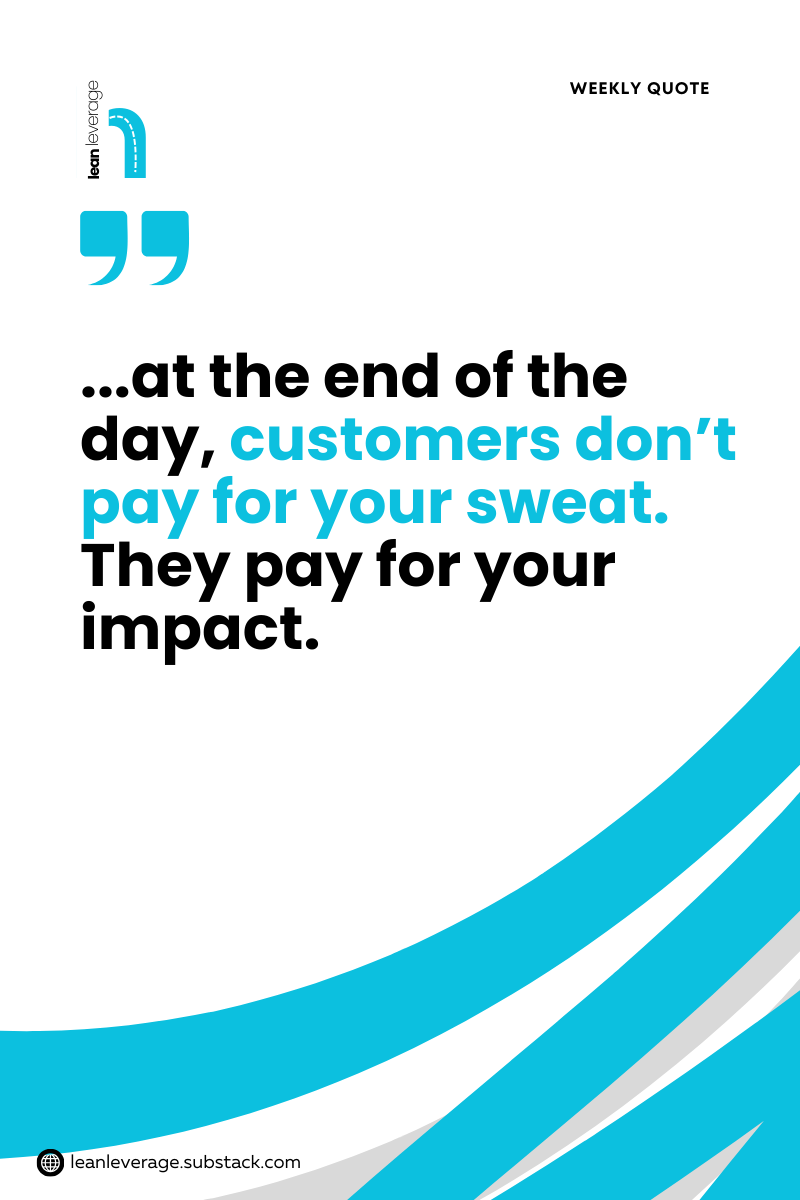Do We Mistake Busyness for Value?
How the obsession with visible activity (“we’re working hard”) often overshadows actual value delivery.
Hello friends,
Somewhere in every office, whether in Nigeria, England, or anywhere else, there’s always that one colleague who is constantly rushing. Typing like they’re assaulting the keyboard, speed-walking down the corridor like Usain Bolt. Dropping into every meeting possible just to declare how “busy” they are.
But if you had the courage to ask them:
“What exactly did all that activity achieve for the customer?”
Silence. Crickets.
That, my friends, is the illusion of activity.
In many workplaces, visible motion is mistaken for meaningful contribution. If you look busy, people assume you must be valuable. It’s why meetings have twelve attendees when four would do the same job. It’s why people carry laptops to lunch (just to look important) or walk fast to the coffee shop.
But Lean teaches us something very different:
Value is defined by the customer, not by how much we sweat or how tired we look at the end of the day.
If the work doesn’t move the needle for the customer (or the business), it’s noise. And noise, no matter how loud, is still waste.
When Busyness Met Reality
There’s one person who drilled this lesson into me (pun intended). Let’s call him Mr Tunde.
Back in the day, I worked for a borehole engineering company in Nigeria. Mr Tunde was the best friend of the MD, more like a co-owner, and also a seasoned leader who had worked in big US corporations before moving back home. The man knew his onions, and maybe his tomatoes and peppers too. He was a senior man!
Now, let me tell you, when Mr Tunde spoke, he made you question your entire existence. He had this unique gift: he could make you realise how wasteful or valuable you were being without changing his tone or the pitch of his voice.
One day, during a team meeting, he turned his attention to my colleague, let’s call him Dami, who worked in sales. Dami’s job was simple: travel around the city, find potential clients, and bring in leads. He had freedom, mobility, and honestly, I envied him a bit.
That day, Dami proudly shared that in three months, he had visited 50 locations and generated about 200 leads. On the surface, it sounded impressive, until Mr Tunde asked how many had actually converted. The answer? Just five.
Mr Tunde shook his head.
“That’s extremely poor. Do the math, Mr Man. What’s your conversion rate? 2.5%”
It hit like a sledgehammer. Dami had been “busy”. Lots of travel, lots of activity, plenty of sweat. But the results? Tiny. Clearly, something in his process was broken. Perhaps he was targeting the wrong locations, which limited opportunities. Maybe his sales pitch wasn’t connecting with clients. It could have been poor timing in his follow-ups, external obstacles that made conversion difficult, or even a lack of persistence in closing deals.
The point was unmistakable: activity without impact is waste.
Dami’s experience isn’t unique; many of us fall into the same trap without realising it.
Why We Fall For It
Dami wasn’t lazy, far from it. In fact, he thought he was killing it. After all, visiting 50 places in three months is no joke.
But here’s the trap: culturally, we tend to equate effort with value.
If someone looks tired, we assume they worked hard. If someone leaves the office late, we clap for them.
And leaders? They often make it worse. Too many reward the people who look busiest, not the ones who quietly deliver impact. So teams adapt. They perform to the wrong scoreboard and start to portray motion.
A Better Way Forward
So how do we escape the “busy = valuable work” trap?
1. Redefine Success
Stop measuring people by how late they stay or how frantic they look. Celebrate impact instead. For example, if one analyst automates a report that saves the team two hours daily, that’s a bigger win than the colleague who spent the whole day formatting PowerPoints nobody reads.
2. Cut the Noise
Not every recurring meeting needs to exist. Not every report needs to be produced. Challenge the clutter. Ask: if this vanished tomorrow, would the customer notice? If the answer is “no,” it’s probably noise. For instance, instead of a 60-minute daily meeting, try a 15-minute huddle with a clear agenda and actions.
3. Make Value Visible
Help teams connect the dots between today’s task and tomorrow’s outcome. For example:
“This improvement saves nurses 20 minutes per shift, which means more time for patient care.”
“This automation cuts finance approvals by two days, which means suppliers get paid faster.”
When people see the direct link between effort and impact, they naturally shift focus from looking busy to delivering value.
Wrapping-Up
Being “busy” is not a badge of honour. If all we reward is motion, we’ll end up with plenty of activity and very little progress.
From a Continuous Improvement lens, the question is simple:
Does this task add value to the customer?
If yes, double down on it. If not, reduce it, automate it, or eliminate it.
At the end of the day, customers don’t pay for your sweat. They pay for your impact.
Until next time,
Tomiwa Femi-Philips
Improvement Enthusiast





Awesome write-up again. this is the reason Data is important and measuring impact with Specific KPIs will help us determine where effort is needed or what type of effort is needed. Otherwise, we'd look busy especially for the ones who likes to work hard and have no impact whatsoever. I look forward to next week!